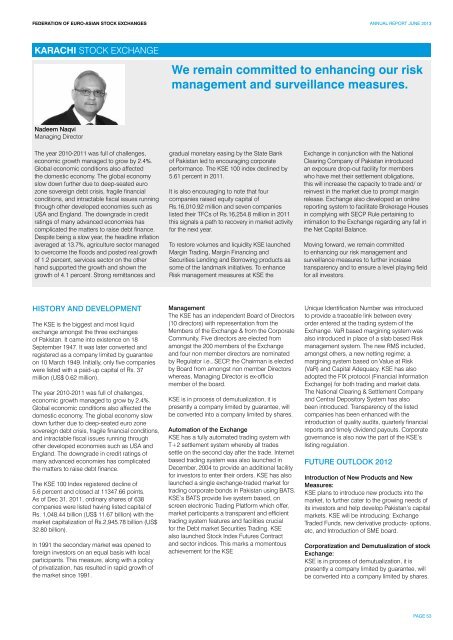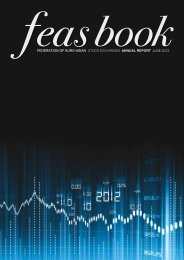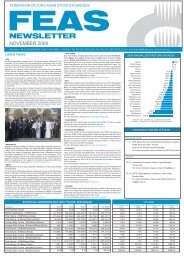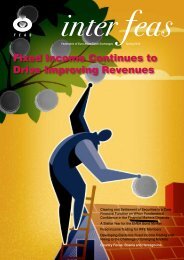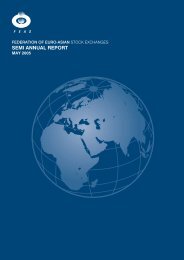JUNE 2013 - FEAS
JUNE 2013 - FEAS
JUNE 2013 - FEAS
You also want an ePaper? Increase the reach of your titles
YUMPU automatically turns print PDFs into web optimized ePapers that Google loves.
FEDERATION OF EURO-ASIAN STOCK EXCHANGES ANNUAL REPORT <strong>JUNE</strong> <strong>2013</strong><br />
KARACHI STOCK EXCHANGE<br />
We remain committed to enhancing our risk<br />
management and surveillance measures.<br />
Nadeem Naqvi<br />
Managing Director<br />
The year 2010-2011 was full of challenges,<br />
economic growth managed to grow by 2.4%.<br />
Global economic conditions also affected<br />
the domestic economy. The global economy<br />
slow down further due to deep-seated euro<br />
zone sovereign debt crisis, fragile financial<br />
conditions, and intractable fiscal issues running<br />
through other developed economies such as<br />
USA and England. The downgrade in credit<br />
ratings of many advanced economies has<br />
complicated the matters to raise debt finance.<br />
Despite being a slow year, the headline inflation<br />
averaged at 13.7%, agriculture sector managed<br />
to overcome the floods and posted real growth<br />
of 1.2 percent, services sector on the other<br />
hand supported the growth and shown the<br />
growth of 4.1 percent. Strong remittances and<br />
gradual monetary easing by the State Bank<br />
of Pakistan led to encouraging corporate<br />
performance. The KSE 100 index declined by<br />
5.61 percent in 2011.<br />
It is also encouraging to note that four<br />
companies raised equity capital of<br />
Rs.16,010.92 million and seven companies<br />
listed their TFCs of Rs.16,254.8 million in 2011<br />
this signals a path to recovery in market activity<br />
for the next year.<br />
To restore volumes and liquidity KSE launched<br />
Margin Trading, Margin Financing and<br />
Securities Lending and Borrowing products as<br />
some of the landmark initiatives. To enhance<br />
Risk management measures at KSE the<br />
Exchange in conjunction with the National<br />
Clearing Company of Pakistan introduced<br />
an exposure drop-out facility for members<br />
who have met their settlement obligations,<br />
this will increase the capacity to trade and/ or<br />
reinvest in the market due to prompt margin<br />
release. Exchange also developed an online<br />
reporting system to facilitate Brokerage Houses<br />
in complying with SECP Rule pertaining to<br />
intimation to the Exchange regarding any fall in<br />
the Net Capital Balance.<br />
Moving forward, we remain committed<br />
to enhancing our risk management and<br />
surveillance measures to further increase<br />
transparency and to ensure a level playing field<br />
for all investors.<br />
HISTORY AND DEVELOPMENT<br />
The KSE is the biggest and most liquid<br />
exchange amongst the three exchanges<br />
of Pakistan. It came into existence on 18<br />
September 1947. It was later converted and<br />
registered as a company limited by guarantee<br />
on 10 March 1949. Initially, only five companies<br />
were listed with a paid-up capital of Rs. 37<br />
million (US$ 0.62 million).<br />
The year 2010-2011 was full of challenges,<br />
economic growth managed to grow by 2.4%.<br />
Global economic conditions also affected the<br />
domestic economy. The global economy slow<br />
down further due to deep-seated euro zone<br />
sovereign debt crisis, fragile financial conditions,<br />
and intractable fiscal issues running through<br />
other developed economies such as USA and<br />
England. The downgrade in credit ratings of<br />
many advanced economies has complicated<br />
the matters to raise debt finance.<br />
The KSE 100 Index registered decline of<br />
5.6 percent and closed at 11347.66 points.<br />
As of Dec 31, 2011, ordinary shares of 638<br />
companies were listed having listed capital of<br />
Rs. 1,048.44 billion (US$ 11.67 billion) with the<br />
market capitalization of Rs.2,945.78 billion (US$<br />
32.80 billion).<br />
In 1991 the secondary market was opened to<br />
foreign investors on an equal basis with local<br />
participants. This measure, along with a policy<br />
of privatization, has resulted in rapid growth of<br />
the market since 1991.<br />
Management<br />
The KSE has an independent Board of Directors<br />
(10 directors) with representation from the<br />
Members of the Exchange & from the Corporate<br />
Community. Five directors are elected from<br />
amongst the 200 members of the Exchange<br />
and four non member directors are nominated<br />
by Regulator i.e., SECP, the Chairman is elected<br />
by Board from amongst non member Directors<br />
whereas, Managing Director is ex-officio<br />
member of the board.<br />
KSE is in process of demutualization, it is<br />
presently a company limited by guarantee, will<br />
be converted into a company limited by shares.<br />
Automation of the Exchange<br />
KSE has a fully automated trading system with<br />
T+2 settlement system whereby all trades<br />
settle on the second day after the trade. Internet<br />
based trading system was also launched in<br />
December, 2004 to provide an additional facility<br />
for investors to enter their orders. KSE has also<br />
launched a single exchange-traded market for<br />
trading corporate bonds in Pakistan using BATS.<br />
KSE’s BATS provide live system based, on<br />
screen electronic Trading Platform which offer,<br />
market participants a transparent and efficient<br />
trading system features and facilities crucial<br />
for the Debt market Securities Trading. KSE<br />
also launched Stock Index Futures Contract<br />
and sector indices. This marks a momentous<br />
achievement for the KSE<br />
Unique Identification Number was introduced<br />
to provide a traceable link between every<br />
order entered at the trading system of the<br />
Exchange. VaR based margining system was<br />
also introduced in place of a slab based Risk<br />
management system. The new RMS included,<br />
amongst others, a new netting regime; a<br />
margining system based on Value at Risk<br />
(VaR) and Capital Adequacy. KSE has also<br />
adopted the FIX protocol (Financial Information<br />
Exchange) for both trading and market data.<br />
The National Clearing & Settlement Company<br />
and Central Depository System has also<br />
been introduced. Transparency of the listed<br />
companies has been enhanced with the<br />
introduction of quality audits, quarterly financial<br />
reports and timely dividend payouts. Corporate<br />
governance is also now the part of the KSE’s<br />
listing regulation.<br />
FUTURE OUTLOOK 2012<br />
Introduction of New Products and New<br />
Measures:<br />
KSE plans to introduce new products into the<br />
market, to further cater to the growing needs of<br />
its investors and help develop Pakistan’s capital<br />
markets. KSE will be introducing: Exchange<br />
Traded Funds, new derivative products- options,<br />
etc, and Introduction of SME board.<br />
Corporatization and Demutualization of stock<br />
Exchange:<br />
KSE is in process of demutualization, it is<br />
presently a company limited by guarantee, will<br />
be converted into a company limited by shares.<br />
PAGE 53


